David Payne: The Rise of the Underdog
“When you have hurdles in your life, you cannot stop. It’s not about how good you are. It’s about how well you come back from falling down.” -David Payne
To be a hurdler requires a warrior’s mentality. When it’s time to go, you can’t hope, you can’t try, you can’t wish. You have to go. For smaller hurdlers, that’s even more true. Everybody lined up on either side of you stands taller than you. You know you have to work harder than your opponents to get up and over each hurdle. You know that it will be harder for you to recover from mistakes. But you can’t concern yourself with any of that. You have to step into the starting blocks knowing you belong. No hurdler embodies that warrior spirit more than 5’11” David Payne, silver medalist in the 110 hurdles at the 2008 Olympics in Beijing, who ran his personal best of 13.02 while finishing third at the 2007 World Championships in Osaka.
The 31-year-old Payne, a native of Wyoming, Ohio in the suburbs of Cincinnati, started his hurdling career relatively late. He did not run track in high school until his junior year, although he had run summer track for a couple years when he was 10-11 years old. But he focused primarily on basketball and soccer until some friends in the grade above him encouraged him to come out for the track team. At first he competed in the 100, 200, and long jump until his friends convinced him to try the hurdles.
[am4show not_have=”g5;”]
[/am4show][am4guest]
[/am4guest][am4show have=”g5;”]
Though he struggled at first, he quickly adapted to the challenges that the hurdles presented. Once he got the hang of it, progress came rapidly. He finished second in the Ohio state meet in the 110 hurdles that year in a time of 14.02, and he also ran 50.0 in the open 400. The 14.02 put him on the radar of many colleges, and it was looking pretty certain that Payne was on his way to earning a scholarship to run track at the next level.
Surely enough, in-state schools like Ohio State University, the University of Akron, the University of Toledo, and Cincinnati University came calling. In addition, out-of-state programs like Florida State and UCLA, among others, were expressing interest. All in all, Payne says that “about 20-25 schools were recruiting him, so he had no doubt he would go to college to run track.
But at the end of his senior year, not long before the state meet, Payne got into big trouble that ultimately derailed his plans and put his dreams on hold. It is a story that can serve as a cautionary tale to high school seniors all over the world about the dangers of being in the wrong place at the wrong time in those last days prior to graduation.
“I was at a party,” Payne explained, “and there were a lot of people there. A lot of football players and basketball players.” Without going into details, Payne made it clear that he felt he was unfairly singled out by school administrators, who suspended him, forcing him to miss the state track meet. This series of events was nothing less than a complete disaster. It scared away all of the colleges, effectively ruining his chances of earning a scholarship. It also meant that he had let his teammates down – not just because of the loss of points he would’ve earned in the hurdles, but also because he was a key member of the 4×100 and 4×200 meter relay teams.
His spirits crushed, he decided he didn’t want to be bothered with college, that he didn’t want to go at all, and that he was done with track. “It was very traumatic,” he said. “It was depressing, embarrassing. My other friends were signing; schools were coming to publicly sign them.”
But after getting over the initial shock, Payne picked himself back up, realizing that not going to school at all would lead him down a dead-end road. “I said I’m not gonna let this [one incident] dictate my outcome.” So he enrolled at Cincinnati. And though he didn’t run track, the hunger to get back out there and prove himself did not die. He knew he had the talent; he just needed the opportunity.
Throughout the indoor and outdoor seasons of his freshman year, Payne attended meets and scoped out his potential opponents. Watching the races further stoked the competitive fires. “I knew I had more ability than the guys I was watching. I knew I could do better than half the people out there.” He determined that he would walk on to the Bearcat squad his sophomore year, and he let head coach Bill Schnier know of his plans. “I went into the coach’s office every day and told him I’m gonna be on the team, I’m gonna win conference in the hurdles. There were athletes in the office looking at me like, Who is this guy?”
It didn’t take them long to find out. Payne did walk on his sophomore year, and he did win the Conference USA championship in the high hurdles. A dead dream had been resuscitated, and even though he didn’t even know it at the time, he was on his way to becoming one of the best hurdlers in the world. Of his sophomore year, 2002, Payne had this to say: “To me it was weird because I was destroying people. It was like, anybody who lined up against me was not gonna win. I don’t think I lost a race that whole year.”
But his success was due mainly to talent alone, as “I really hadn’t contoured my technique yet.” Enter coach Elisha Brewer, who had been an All American hurdler at the University of Arkansas, and who currently coaches hurdlers at Kansas University. The first thing Brewer did was adjust his block start. “I had the wrong leg in front in the block,” he said. “I must’ve been taking nine steps [to the first hurdle] because I don’t think I was taking seven.” Brewer also helped him to fix his lead leg, which would curve inward when he cleared the hurdle. Payne had grown used to compensating for such flaws with his speed and athleticism, so accepting feedback and instruction from a hurdle-knowledgeable coach proved to be a bit difficult at first. “I had to get used to taking advice,” he said, “because I had been winning.”
With Coach Brewer’s help, Payne went from being “a 14.0 hurdler to a 13.4 hurdler.” In his last two years at Cincinnati, Payne won the Conference USA championship. At NCAA nationals he finished third and fifth, running 13.53 in 2003 as a junior, which was his fastest collegiate FAT time.
In 2005, Payne continued to train in Cincinnati although he no longer competed for the team, as he was only two classes away from graduating. He was now being coached by former teammate Brandon Hon, since Brewer had moved on to Kansas. Hon, who had run professionally for the Indiana Invaders for two years, returned to Cincinnati. While it was weird at first to be coached by a former teammate and opponent (“We were competitive from day one”), Payne and Hon got along very well. Under Hon’s tutelage, Payne continued the improvement that had begun with Coach Brewer. At the USA Outdoor Championships, he finished fifth in 13.33, creeping ever closer to that elite level. In 2006, he finished sixth at USA’s in 13.42. After that season he felt like it might be time for a change of scenery in order to get away from the cold Ohio weather.
Payne moved to Hampton, Virginia, where he met coach Maurice Pierce through his agent. Training partners included 100m hurdler Kellie Wells, quarter-miler Francena McCrory, and 400 hurdler Michael Tinsley. Pierce, whose coaching style was much more intense and demanding, pushed Payne to even greater levels of success. At USA Outdoors, Payne finished fourth in 13.22, just missing a spot on the World Championship team that would travel to Osaka later that summer. No shame in the game though, because the three athletes ahead of him – Terrence Trammell, Dominique Arnold, and David Oliver – were all exceptional hurdlers. Trammell and Arnold had already established themselves as legends in the event, and Oliver was one of the best young hurdlers on the rise.
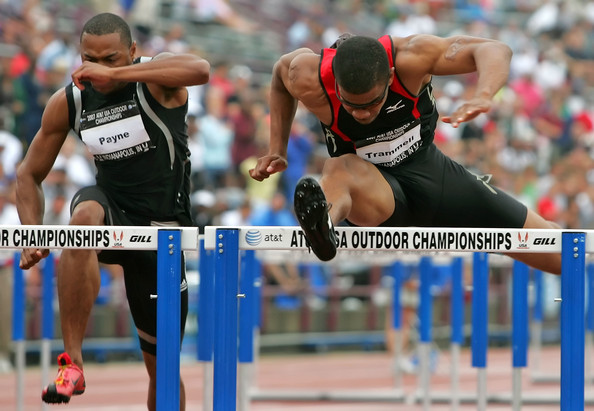 Payne and Trammell battle it out at the 2007 US Championships.
Payne and Trammell battle it out at the 2007 US Championships.
Despite not making the team, Payne continued to train rigorously and to compete on the professional circuit. That’s why he didn’t panic when he received an early morning phone call the day prior to the first round of the World Championships. It was his agent calling to inform him that American record holder Arnold would not be competing due to injury. Payne would have to hop on a plane immediately in order to get to Osaka in time to replace Arnold. So that’s what he did.
“It was crazy how it happened,” Payne recalled. “A week before that I left [my agent] Kevin Brown and signed with Mark Block of Total Sports. I had only talked to him once. The second time I talked to him was when he called me at like four in the morning asking if I wanted to go to Osaka. Fifteen-hour flight. I went to sleep for six hours on the plane. Woke up, got my bib number and ran my first race.”
Despite the ridiculously quick turn-around time, Payne entered Osaka feeling confident he could medal. The previous week in Doha, he had run 13.12, defeating Trammell there. “That’s when I knew I was ready,” he said. “In Osaka, when I was warming up before the first race, the other coaches were like ‘you’re coming off the hurdle so fast?’ I’d only been there like half a day.”
In the final, Trammell rocketed out to a fast start and command of the race. Liu made a huge surge in the second half of the race and edged Trammell at the finish line, 12.95 to 12.99, while Payne ran the best race of his life, crossing the line a hair behind Trammell in 13.02.
Payne credits coach Pierce’s strict training regimen for his ability to step onto the track and perform at such a high level on such short notice. “I didn’t make the team,” Payne said, “but he still had me training hard. That’s why I went over there and got a medal. I had a bone bruise in my heel [after USA Nationals]. That whole month and a half I would walk around in a cast. I would take off the cast, run ten 200’s, put it back on, then go to work at Home Depot. It was a grind, but you don’t really realize how much you’re grinding until it pays off.”
Payne feels he actually benefitted from being put in such a spontaneous situation in which little was expected of him. “I felt at first it was bad to be an underdog,” Payne said. “But I couldn’t be crying wolf. In races, it made me more aggressive to be the underdog. The announcer would go down each lane before the race, saying all the accolades for every athlete. He won this, he won that. Then he’d get to me and it would just be like, ‘David Payne.’ That fueled my fire. It was like, these fools don’t know what’s about to happen.”
Being the beneficiary of other hurdlers’ injuries became a theme in Payne’s career for the next two years, as Liu Xiang and Terrence Trammell were injured in the 2008 Olympics, and Liu and Robles were injured for the 2009 World Championships. Payne takes umbrage to the idea that any success he has earned has been due to the misfortune of others, as he has suffered more than his fair share of injuries himself. “I have a philosophy,” he said, “where if you’re on the line, don’t complain. Injured, sick, whatever, I’m not trying to hear that. The world is so judgmental that it doesn’t matter what’s wrong with you. I try my hardest to just focus on my own race and not worry about who’s there and who’s not there. You have to have tunnel vision. That’s when I know I’m on. You don’t have control over what anyone else does.”
Payne made the 2008 Olympic team by finishing third at the US Trials behind Trammell and Oliver. But Trammell got hurt in the first round of the Games and did not finish the race. That left Oliver and Payne as the only Americans left. Liu also famously did not make it past the first round, although he gamely tried to make it through on a bad achilles, determined not to let down the fans of his home country. That meant that two predicted top three finishers were out of the mix.
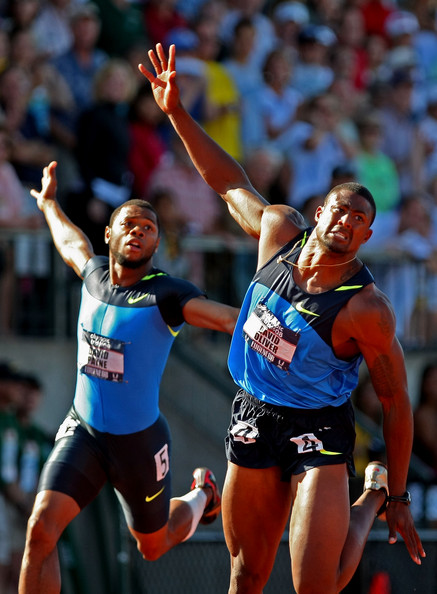 Payne and Oliver cross the line and look to the jumbotron at the 2008 US Outdoor final.
Payne and Oliver cross the line and look to the jumbotron at the 2008 US Outdoor final.
Payne did not celebrate their departure. “Robles, Liu, and Trammell – that was everybody else’s [predicted] 1-2-3. I was there to win a medal.” With Trammell out, most Americans were pinning their hopes on Oliver to be the one to put the USA back on top in an event that the US had previously dominated, but in which it had won no gold medals since Allen Johnson’s 2003 World Championship victory.
The final was dominated by Robles, who won going away in 12.93. Payne ran a very aggressive race, although he hit some hurdles, and finished second in 13.17, one hundredth of a second ahead of Oliver. “I just maintained my aggressiveness,” Payne said. I was just happy to maintain my race. In the rounds I saw Oliver run really fast. He ran like 13.0, 13.1 (13.16, to be exact, in the second round). I try to be consistently gradual. The old school vets always barely make it into the next round. They don’t want to waste energy. I ran fast enough [in the rounds] to get a good lane. In the semis, that’s where it gets real. If you don’t do well there, you don’t get to the finals. In the finals you can relax, show off, do what you’ve done to get there.”
Payne enjoyed his Olympic experience, but keeps it in perspective. “I don’t mean say this to mean that I didn’t value being an Olympian, because it meant a lot to compete for my country, but to me the Olympics is just another race. My family was there, and I really enjoyed the atmosphere, but I feel like everybody only knows about track once every four years. I got a medal the year before but nobody knew anything about me. People don’t know we do this all the time. Don’t get me wrong, it was a great experience, but I just wish that people gave our sport more shine during non-Olympic years.”
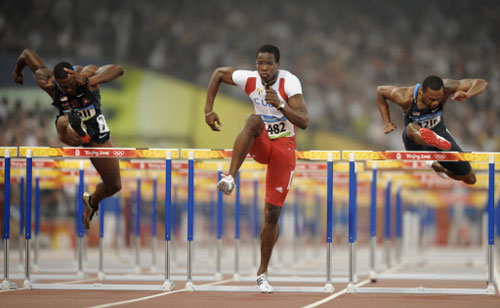 Dayron Robles (center) leads the way as David Oliver (left) and Payne (right) race to bronze and silver medals, respectively, at the 2008 Olympics.
Dayron Robles (center) leads the way as David Oliver (left) and Payne (right) race to bronze and silver medals, respectively, at the 2008 Olympics.
At the 2009 USA Outdoor Championships David Oliver was injured, so Trammell was the odds-on favorite. In a thrilling final, Payne edged Trammell by thousandths of a second, as they were both given the official time of 13.12. Payne recalls that after the race, the NBC analyst doing the post-race interviews initially interviewed Trammell instead of him, just adding to his underdog status. Fortunately, fellow Bearcat alum Lewis Johnson stepped in and gave Payne a chance to speak into the camera. But Payne didn’t let the situation bother him. “The [television networks] make you look how they want you to look,” he said. “It was a great race. Aries [Merritt] was right there too. I was just very happy to win.”
At the World Championships later that summer, Trammell was again the favorite to win. Robles was out with injury, Liu was still injured, so Trammell was the only big name left. In the final, however, it was Ryan Brathwaite of Barbados who took the world by surprise. Trammell, Brathwaite, and Payne ran neck-and-neck throughout almost the entire race. Brathwaite won by a lean in 13.14, while Payne and Trammell were yet again given the same time, 13.15. This time, Trammell was given the edge for the silver by thousandths, and Payne was awarded the bronze. “At Worlds he got the better of me,” Payne said. “I’d rather he be the US champ and me be the silver medalist, but that’s how it goes.”
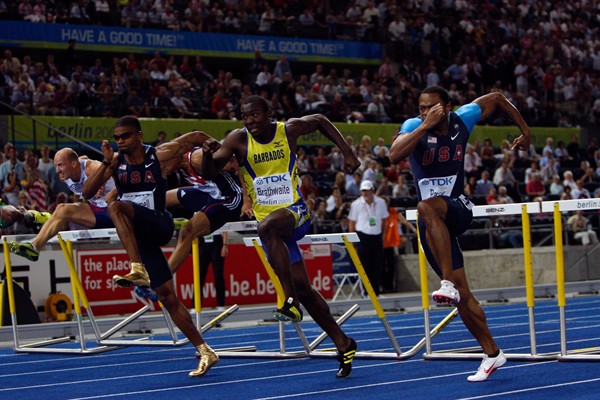 Trammell, Brathwaite, and Payne clear the tenth hurdle and sprint for the finish line.
Trammell, Brathwaite, and Payne clear the tenth hurdle and sprint for the finish line.
That stretch from 2007-2009 has proven to be the peak of Payne’s career up to this point. Since then he has suffered a series of stress fractures and broken bones, the latest and greatest being a broken femur that he suffered in Lausanne last summer. He is rehabilitating now, and is not ruling out a return to the track. “I’m gonna try to run again,” he said, “but I won’t feel bad about it if I can’t.”
Whether he returns to competition or not, Payne has arguably had the greatest career of a sub-6’0” hurdler in the history of the high hurdles. Though officially listed on the USATF website as 6’1”, he says, “No, I’m 5’11”.” To run 13.02 and to earn medals at major championships at his height is quite a remarkable accomplishment, as the sub-6’0” hurdler is becoming more and more rare as the years go on.
Payne’s achievements can be attributed to several factors – his warrior spirit, the technical adjustments he has made over the years, and the excellent coaching he has received throughout his career.
In regard to technique, Payne says that he learned early on that he couldn’t attack the hurdles with the same ease of motion that taller hurdlers could. “I feel like taller hurdlers don’t really have to dive up and into the hurdle as much,” he said, “because their hips are already high. I have to jump up slightly. When I land, I have to make sure I don’t come down on my hell. If you maintain that forward lean, you can’t fall down backward. You’ll fall forward and keep your momentum.”
Because of this subtle but significant adjustment, Payne has been able to run clean races without sacrificing aggression. “Hitting hurdles was an issue in college,” he said, “but not professionally. In college I would ride the hurdle down when the other guys were chasing me. I would cheat with the lead leg. I would snap it down before I was over the hurdle. As a smaller hurdler, I have to have patience, and jump a little higher than everyone else.”
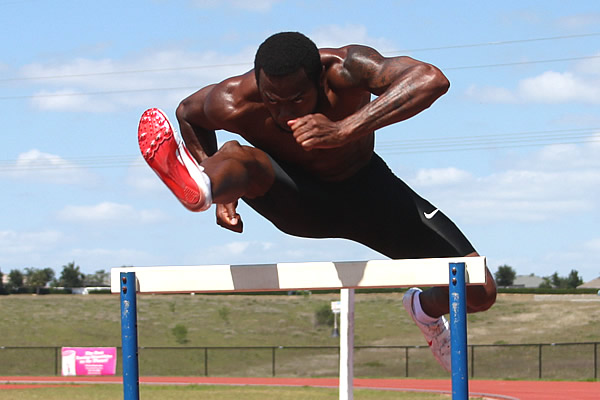 Payne exhibits the deep lean that smaller hurdlers must employ to get up and over the barriers.
Payne exhibits the deep lean that smaller hurdlers must employ to get up and over the barriers.
If there is an aspect of his technique that he feels still needs work, it would be his lead arm. He tends to raise the elbow very high, so that his forearm is at a slanted angle, with the elbow above the hand. Then as he descends, he pulls the elbow down and keeps running. It’s actually an efficient style for a smaller hurdler, although there is a pause on top. “I developed my lead arm over a period of time,” he said. “All my coaches would tell me about it. Elisha and Brandon pointed it out.”
David Oliver’s coach, Brooks Johnson, also noticed it. Payne trained with Oliver under Johnson’s guidance in 2011-12. Former training partner Kellie Wells had encouraged him at the time to move to Florida. “Brooks talked about an imaginary box,” Payne explained. “You want your arm in that imaginary box. So that’s something I need to fix.”
After reflecting back on the expanse of his career, dating back to his days as a junior at Wyoming High School in Ohio, Payne can appreciate how much he has grown as a result of his hurdling endeavors.
“The hurdles have taught me to be a man,” he said. “My races are like metaphors of my life experiences. A lot of hurdlers who could be great don’t become great because they can’t deal with the life issues. People like D.O. and Ryan Wilson are such great examples of people who have overcome life’s obstacles. Really, hurdling is about how much you can endure. I’ve had several broken bones. Looking back at all the things I’ve been through, every one of them is a hurdle. You get over one, you make sure the next one is better. When you have hurdles in your life, you cannot stop. It’s not about how good you are. It’s about how well you come back from falling down. You learn how to run the hurdles as you grow as a person. You start to be more well-rounded and a more mature person and hurdler all together. You can’t separate the hurdles from life.”
Ironically, after training in Virginia with Coach Pierce and in Florida with Coach Johnson, Payne’s journey has taken him back to Cincinnati. He plans to take those two classes he needs to graduate in the spring. He’ll also be coming back from a broken femur, which means he will once again be the underdog, the little guy with the big heart intent on defying the odds. “I’m so determined to run again,” he said.
[/am4show]
